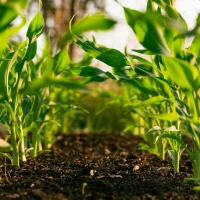The global food system is undergoing significant challenges with the increasing population, climate change, and depletion of natural resources. As a result, there has been a growing interest in creating a sustainable food system that promotes environmental stewardship, social equity, and economic viability. Organic agriculture, with its focus on ecological practices and reduced reliance on synthetic inputs, offers a promising pathway towards achieving a sustainable food system. In this article, we will explore 33+ innovative practices in organic agriculture that are transforming the way we produce, distribute, and consume food.
1. Organic Agriculture: A Brief Overview
Before diving into the innovative practices, let’s start by understanding the foundational principles of organic agriculture. Organic agriculture is a holistic approach to farming that emphasizes the use of natural inputs, biodiversity conservation, and soil health. It promotes the cultivation of crops and the rearing of animals in harmony with nature, without the use of synthetic chemicals, genetically modified organisms (GMOs), or irradiation.
Organic farming systems employ a range of techniques such as crop rotation, composting, green manuring, and biological pest control to maintain soil fertility, control pests and diseases, and promote biodiversity. By avoiding the use of synthetic fertilizers and pesticides, organic agriculture minimizes the environmental impacts associated with conventional farming methods.
2. Innovative Practices in Organic Agriculture
2.1 Regenerative Agriculture
Regenerative agriculture goes beyond the principles of organic agriculture by actively replenishing and restoring the health of the soil, water, and ecosystems. This approach focuses on enhancing biodiversity, sequestering carbon, improving water management, and fostering resilience in agricultural systems. Some of the innovative practices within regenerative agriculture include:
- Cover cropping: Planting cover crops between cash crops to protect and improve the soil structure, reduce erosion, and promote beneficial soil microorganisms.
- Conservation tillage: Reducing or eliminating the use of tillage to preserve soil moisture, organic matter, and soil structure.
- Agroforestry: Integrating trees with crops or livestock to enhance biodiversity, carbon sequestration, and ecosystem services.
2.2 Precision Farming
Precision farming utilizes advanced technologies to optimize the use of resources, improve crop management, and reduce environmental impact. It involves the use of sensors, drones, GPS, and data analytics to monitor and manage field conditions, crop health, and nutrient requirements in real-time. Some examples of precision farming practices in organic agriculture include:
- Variable rate application: Applying inputs, such as fertilizers and irrigation, based on site-specific conditions and crop needs, resulting in more efficient resource utilization.
- Remote sensing: Using aerial or satellite imagery to detect crop stress, diseases, and nutrient deficiencies for timely interventions.
- Automated systems: Implementing robotic or autonomous systems for seeding, harvesting, and weed management, reducing labor requirements and improving efficiency.
2.3 Urban Agriculture
Urban agriculture involves the cultivation of food within cities, utilizing both indoor and outdoor spaces. It offers numerous benefits, including local food production, improved access to fresh produce, and reduced transportation emissions. Several innovative practices within urban agriculture are contributing to the sustainable food system:
- Rooftop gardens: Utilizing rooftops of buildings for vegetable and fruit production, providing urban dwellers with access to fresh, locally grown food.
- Vertical farming: Growing crops in vertically-stacked layers using hydroponic or aeroponic systems, maximizing land utilization and minimizing water consumption.
- Community gardens: Establishing shared spaces where local residents can grow their own food, fostering community engagement and promoting food security.
2.4 Sustainable Aquaculture
Aquaculture, or fish farming, is another essential component of a sustainable food system. Organic aquaculture practices prioritize animal welfare, use of sustainable feeds, and reduction of environmental impacts. Some noteworthy innovations in sustainable aquaculture include:
- Closed-loop systems: Implementing recirculating aquaculture systems that minimize water use and waste discharge, creating a more controlled and sustainable production environment.
- Integrated multitrophic aquaculture: Combining different species in the same system to utilize waste products as inputs for other organisms, minimizing nutrient pollution and increasing resource efficiency.
- Seaweed and shellfish farming: Cultivating marine plants and shellfish that serve as natural filters, absorbing excess nutrients and improving water quality.
2.5 Biological Pest and Disease Management
Organic agriculture prioritizes the use of biological pest and disease management techniques over synthetic pesticides. These practices focus on enhancing natural pest control mechanisms and preventing outbreaks through a combination of strategies:
- Biological control: Introducing beneficial insects, such as ladybugs or predatory mites, to control pests naturally.
- Crop diversification: Planting a variety of crops and intercropping to disrupt pest life cycles, minimize pest pressure, and promote beneficial insects.
- Traps and pheromones: Using traps and pheromones to monitor and capture pest insects, reducing the need for chemical interventions.
Comparison Chart: Organic Agriculture vs. Conventional Agriculture
To highlight the differences between organic and conventional agriculture, let’s compare various aspects of the two systems:
| Aspect | Organic Agriculture | Conventional Agriculture |
|---|---|---|
| Use of synthetic inputs | Avoided | Commonly used |
| Soil health and fertility | Prioritized through organic matter and biodiversity | Often dependent on synthetic fertilizers |
| Pest and disease management | Emphasis on biological control and prevention | Rely heavily on synthetic pesticides |
| Biodiversity conservation | Promoted through crop diversity and habitat preservation | Less focus on biodiversity |
| Environmental impact | Lower carbon footprint and reduced water pollution | Higher use of energy, water, and synthetic inputs |
| Food safety and quality | Restricted use of GMOs, synthetic hormones, and antibiotics | Reliance on GMOs and chemical inputs |
Conclusion
Creating a sustainable food system is crucial for the well-being of our planet and future generations. Organic agriculture, with its emphasis on ecological practices and reduced reliance on synthetic inputs, offers a pathway towards achieving this goal. Through the implementation of innovative practices such as regenerative agriculture, precision farming, urban agriculture, sustainable aquaculture, and biological pest management, we can transform the way we produce, distribute, and consume food.
It is essential to recognize that the transition to a sustainable food system requires collective action from farmers, consumers, policymakers, and businesses. By supporting organic agriculture and embracing these innovative practices, we can move towards building a regenerative and resilient food system that nourishes both people and the planet.
References:
- Smith-Spangler, C., Brandeau, M. L., Hunter, G. E., Bavinger, J. C., Pearson, M., Eschbach, P. J., … & Bravata, D. M. (2012). Are organic foods safer or healthier than conventional alternatives?: A systematic review.
- PRiME Framework. (2021). Sustainable farm management: 14 ways regenerative agriculture can help.










